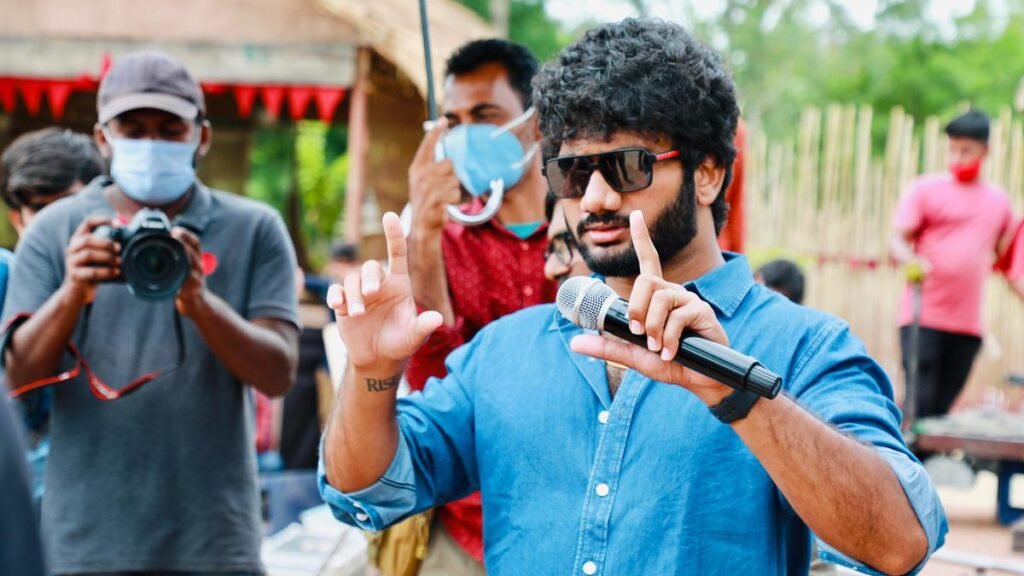The upcoming film “HanuMan” marks the debut of the Prasanth Varma Cinematic Universe (PVCU) in Telugu cinema, set to hit theaters on January 12. Focused on the journey of Teja Sajja’s character, an underdog from the fictional town of Anjanadri, the movie explores his transformation into a superhero, empowered by the superhuman abilities of Lord Hanuman. Director Prasanth Varma, speaking from his studio-like office in Manikonda, Hyderabad, emphasizes that while the film boasts impressive visual effects, it is not intended to be a grand spectacle like “Avatar” or “Baahubali.” Instead, he describes it as a meticulously crafted, low-budget superhero film with a narrative structure reminiscent of Disney or Chandamama comics.
Detailing the protagonist’s relationships and challenges, Prasanth explains that Teja’s character, supported by his sister (Varalaxmi Sarathkumar) and girlfriend (Amritha Aiyer), encounters various obstacles. The story unfolds as he draws strength from Hanuman, propelling the narrative forward. The journey from the inception of the idea to the film’s imminent release spanned three years, with the director referring to the entire process as a valuable learning curve.
Rajamouli’s guidance
At various stages of the film, Prasanth Varma sought counsel from renowned director S. S. Rajamouli, emphasizing the value of technical knowledge and hands-on methods, even with a dedicated VFX team. Despite working within a limited budget and without access to major studios, Prasanth collaborated with three emerging VFX studios, leveraging the expertise of professionals who had previously worked on Rajamouli’s films. Drawing inspiration from Rajamouli’s approach, Prasanth personally involved himself in the minutiae of the VFX process, echoing the acclaimed director’s hands-on style. He acknowledges the significance of such direct involvement, making minor adjustments himself rather than solely relying on verbal explanations.
Prasanth credits Rajamouli not only for his technical prowess in films like “Eega” (2012) but also for providing guidance on the overall presentation of “HanuMan.” The film, originally conceived as a Telugu project, expanded exponentially, mirroring the growth of the divine character it portrays. Plans are underway to dub and release the film in 11 languages. Following Rajamouli’s advice, the release strategy involves launching in Indian languages first and subsequently in foreign languages, including French, to manage the workload effectively.
Writing team
The narrative for “HanuMan” originated from Prasanth Varma and underwent development by his team at Scriptsville, a writing venture co-founded with his sister Sneha. Reflecting on the recent trend in Telugu cinema to embrace a writers’ room approach, Prasanth notes that it essentially extends the tradition of story discussions from earlier years. The benefit lies in incorporating diverse perspectives, encompassing social contexts and gender-specific insights for characters. However, Prasanth emphasizes that the ultimate decision rests with the director, who must determine what aligns best with the film’s vision. He underscores the importance of clearly defining credits and compensation for writers to prevent potential conflicts.
Fictional, parallel world
The unfolding tale of “HanuMan” takes place in Anjanadri, a town situated within a parallel universe known as Akhand Bharat. Director Prasanth Varma expresses the creative freedom afforded by this setting, envisioning an India untouched by Mughal and British invasions. Akhand Bharat serves as a contemporary parallel world where the people’s behavior mirrors our own, with references to films like Baahubali existing in their culture. However, this world lacks a city akin to Mumbai.
This parallel universe serves as the backdrop for upcoming superhero films that will follow in the footsteps of “HanuMan.” Among them are “Athira” and an untitled project featuring a female superhero. Prasanth expresses enthusiasm about bringing a female director on board for the latter film, emphasizing his intention to diversify the directorial roles within the superhero universe. While he won’t helm every superhero film, Prasanth reveals meticulous world-building efforts, including detailed histories of the parallel world, and a blueprint for all the upcoming films. Plans are set to commence work on these projects shortly after the release of “HanuMan.”
‘HanuMan’ studio
Significant portions of “HanuMan” were shot in Vattinagulapally on the outskirts of Hyderabad, where a temporary studio named Hanuman Studio was established with the assistance of production designer Nagendra. The team leased land in Vattinagulapally for the shoots, utilizing green screens for various scenes, and the area has now become a hub for other film productions. Additionally, for wide-angle visuals, the crew traveled to Paderu and Maredumilli.
One notable sequence required the replication of an outdoor scenario in a massive indoor set to maintain optimal lighting conditions. Prasanth expresses gratitude to the producer, Niranjan Reddy, for supporting the decision to create an indoor set at the cost of ₹65 lakh to control environmental factors.
“HanuMan” involved 120 days of shooting and extensive pre- and post-production efforts. The team faced challenges throughout the process, adapting and problem-solving along the way. For instance, shooting “superspeed” sequences posed difficulties, particularly in capturing the hero running barefoot, which led to adjustments in filming techniques.
Various techniques were employed in the film, including superspeed, unreal engine, basic matte painting, 3D, and Artificial Intelligence (AI). Prasanth highlights the role of AI in speeding up the post-production process, allowing tasks that might take months to be completed within a week. Post-release, the team plans to share videos detailing the behind-the-scenes process of creating specific sequences.
With approximately 1,600 VFX shots, constituting around 30% of the film, “HanuMan” seamlessly integrates real and tech-generated elements. Prasanth mentions that animals like rats, a cheetah, a tiger, and a monkey were created through VFX, with certain scenes challenging the audience to distinguish between reality and CGI.
Having watched “HanuMan” over a hundred times during post-production, Prasanth eagerly anticipates the audience’s response. Test screenings with diverse participants yielded positive feedback on the emotional resonance of the film, addressing a previous critique about the need for a stronger emotional connection in his earlier works. Prasanth emphasizes the importance of balancing cutting-edge technology with emotional storytelling.
